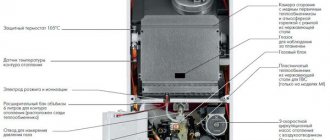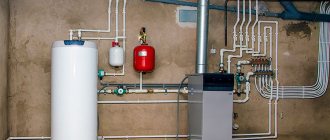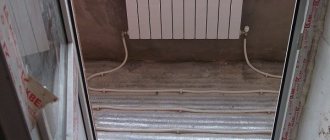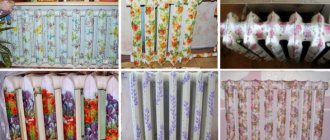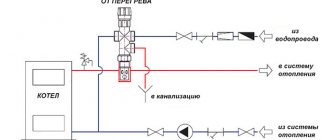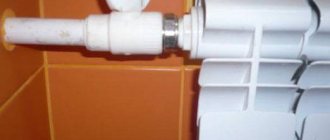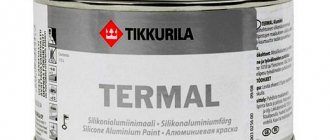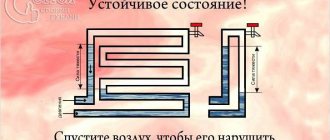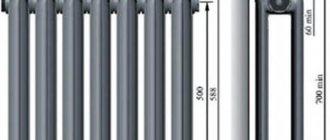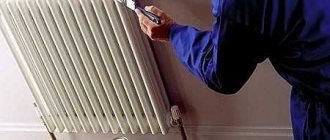A little about heat engineering and radiator grilles
Even if you need radiator grilles for decoration, do not forget that the radiators must heat the room. Any screen reduces heat transfer, even the most delicate and delicate one. Another question is that one will reduce the amount of heat transferred by 10-15%, and the other by 60% or even more. It is unlikely that you will want to sit in a beautiful but cold room, so when choosing a decorative grille you need to take into account how the heat will spread.
Heat Spread
The principle of heat transfer from a heating radiator without a grille is shown in the figure. The main idea is that air should come from below, pass along the battery, heat up, and go up. This is how our heating works. When choosing a grille or screen, you need to remember this. For normal air circulation, it is necessary that there is a gap at the bottom and no cover at the top. As a last resort, the lid should have a large perforation area.
Not a bad option - large holes allow air to move freely
But if you look at many of the decorative grilles, you can immediately tell that the room will be cold. This especially affects grilles on heating radiators in the form of a box, which have walls on all sides. If they are very lacy, as in the photo above, there is no particular problem, but if they are made of solid wood (as in the photo below), with almost no or minimal perforations, be prepared for heating inefficiency.
The top of the battery is covered with a solid layer of wood without holes
Wood is, of course, an aesthetic material, but it has a high heat capacity. Until the wood heats up, the room will be cold. And since the array is located above the radiator and there are no holes for circulation, the radiator under such a grille will be hot, but the room will be cold.
About heat transfer
A heating radiator hidden behind an elegant decorative screen will add positive emotions to our lives. Such a thing can not only hide unsightly old structures, but also become part of the style of the room. When planning to create something grandiose for radiators in your apartment, you should not forget about preserving the heat transfer of the device.
Heat transfer table for heating radiators
Thermal energy consists of two parts:
A decorative screen on the radiator will inevitably block access to the flows of two energies, therefore, some of the heat will not flow into the house. If the box-shaped design is unsuccessful, the hot air will partially accumulate inside without being able to escape outside. The heat exchange process is disrupted; part of the heat will simply transfer to the next room. When packing a radiator in a beautiful box, 3-7% of heat energy is lost. It is impossible to completely avoid such a loss, but there is a possibility of reducing it. To do this, you need to choose the right screen design.
It is important! The screen installed on the radiator is responsible for the spread of infrared flows and air distribution. Therefore, the front part of the structure must have many holes.
Wooden grill for battery
READ How to install sense 7 on htc one m7
Screen Features
Screens for heating radiators, as is commonly thought, perform mainly a decorative function and mask the unattractive appearance of radiators.
However, they also have another benefit - a protective function. Firstly, we are talking about protecting the radiator itself from mechanical damage and dust accumulation. And, secondly, protecting household members from burns that can occur from touching hot radiators.
A protective screen for a heating radiator is especially relevant for families with children.
As for the choice of screen, it depends on many factors and this is not only the design of the external design and the material of manufacture. It is important to consider the convenience of each model and energy performance.
If the choice falls on wooden screens, then remember that there will be less heat in the room. In addition, cleaning the area where the radiator screen is installed will be difficult.
The appearance of the screen can be completely varied, but one rule must always be followed. Any screen must contain perforation in the form provided by the pattern, but the main thing is that it exists.
If the choice fell on housing boxes to mask the radiator, then they must be removed completely or opened.
This condition is necessary to maintain the cleanliness of the radiator, better heating in cold weather and for access in emergency situations.
Mounting features
Grilles on heating radiators must be mounted in such a way that you can easily and quickly access heating appliances and pipes. Periodically, at least twice a year, the heating system elements must be cleaned of dirt and dust, so access is necessary. In addition, emergencies arise from time to time. In this case, a quick reaction is required and there is no time to unscrew the fasteners. Therefore, try to come up with a fastening system that allows you to remove the screen in one motion.
The easiest way is with mounted or attached screens. They are removed/retracted in seconds. But flat, covering radiators in niches and box screens that are attached to the wall are the most problematic. But even here everything is solved simply. You can secure the box to the wall using two strips: one on the box, the second on the wall. The whole secret is that the top edge of the planks is beveled (you can see it in the picture). The one that is nailed to the wall has a slope towards the wall, the one on the frame has a slope towards the grating. When the box is installed in place, it turns out something like a lock.
How to fix a screen box for a heating radiator on the wall
Another option is to attach metal plates to one of the strips and magnets to the other. Or attach not a wooden plank to the wall, but a metal corner, for example.
In the case of flat screens, the solution may be the same - metal plates and magnets. Another option is hooks and loops. It is easy to implement, but not very convenient to use: while you get into loops, you have to suffer. There is also a difficult-to-install but convenient way: make a screen like a sliding door.
Sliding screens for radiators
You can take the guides that are sold for furniture doors, install them, and insert the screens into the corresponding grooves. If you do not plan to actively use the niche near the battery, you can not install roller mechanisms, but it will be difficult to move them away. This method, by the way, can also be used for the box lattice. It can then be nailed “tightly” to the wall, and the front wall can be made movable.
Purpose of decorative grilles
A well-chosen protective grille should not disturb the harmony of the room. Its task is to become an excellent stylistic addition to the interior and an effective camouflage device behind which an unaesthetic battery is hidden.
The functional purpose of the radiator is to heat the room. Therefore, the protective screen should not interfere with effective heat transfer.
If this element retains heat, the room will become cold, and additional heating sources will have to be used, and this entails an increase in utility bills.
We recommend: Korean gas boilers: detailed review and recommendations for choosing wall-mounted and floor-mounted, single-circuit and double-circuit models, reviews from owners, comparison of their characteristics and costs
But you can choose a grille configuration that will not only hide the radiator, but also increase the flow of heat into the room.
In addition to hiding the surface of the battery, the decorative grille performs protective functions. Firstly, the screen protects the radiator from dust and contamination. Secondly, it doesn't get as hot as a battery. This means that you can touch it without fear of getting burned. This is especially important for families with children or pets.
In addition, the screen can be quickly dismantled for the purpose of prevention, repair or replacement of the heating device.
Types of screen devices
The main part of the screen is its front part in the form of a rectangle with holes that provide access to warm air into the room. The presence of top and side surfaces often dictates where the radiator is installed.
There are three main types of screen based on installation method:
Flat screen for radiator
Flat panels are installed if the battery is in a niche. The radiator located under the window sill can also be decorated with a separate panel and decorated in the same style as the interior of the room. This option is also made in the form of a facade on legs, which will cover the device like a screen.
The hinged cover is mounted on the batteries, which protrude slightly forward. It usually consists of two surfaces located on top and on the front of the radiator. Its sides remain free.
Screen with hinged part
A box or imitation “a la cabinet” completely hides the radiator. This option creates an additional surface on which you can hold various small items and place lamps. But here we should not forget about the presence of many holes for the release of warm air.
Box for heating radiator
Tasks and materials
Most often, grilles are installed on heating radiators for decoration - not all heating devices look attractive, but the grilles are sometimes made very beautiful. The second task that battery screens often perform is to cover sharp and hard edges. This is relevant in families with children, especially if old-style cast iron radiators, the “accordion” type, are installed. Their shape is dangerous, and their appearance is unattractive; they would only be suitable in loft-style rooms.
Grates for heating radiators are made from different materials:
- Metal screens for batteries are produced in large quantities. They are made from thin sheet steel, which is then coated with paint. For the most part, they don't cost much, but they also look average. The service life depends on the quality of the paint. Powder enamels are preferable. They last longer, maintaining their attractiveness for decades. From the point of view of the effect on heating, metal screens for radiators are the best choice. The metal heats up quickly, and then it begins to radiate heat. So the option is inexpensive (usually) and does not greatly affect the temperature in the room (if there is perforation).
The most common form, and the design can be anything
- Forged grilles are very beautiful. But the forging is too delicate, so some kind of background is required, and it is often made contrasting in order to highlight the forged elements more clearly. To ensure normal air circulation, it makes sense to make the “background” from a perforated metal sheet.
The forging is very beautiful
- Wooden grilles and screens. Wood has always been and remains a premium material. The high plasticity of the material allows them to be made in different styles and shapes. And although there are inexpensive products made from wood, they look very good. But, as mentioned above, a radiator covered on all sides with wood transfers little heat to the room.
Wood always looks solid
- MDF and HDF. For production, laminated sheet materials are used. Staz should say that no binders are used in the production of MDF and HDF. The softened wood fibers are pressed, releasing lignin, a natural binder found in wood. Lignin is what glues fibers together. So both of these materials are absolutely safe. While we know products made from MDF more or less well, HDF is an unfamiliar material for many. It differs from MDF only in the pressing conditions. It is molded under higher pressure, as a result it is very thin (3-4 mm), but more dense and uniform. HDF holds its shape well, which is why openwork grilles for heating radiators are often made from HDF. From the point of view of their effect on heating, they are slightly better than wood - the layer is thinner, and there are usually more perforations.
Openwork decorative grilles for batteries are usually made from MDF and HDF
- Plastic. Plastic products are most often used in bathrooms and toilets. This material is the most hygienic; it can be washed an unlimited number of times. For production, heat-resistant plastic is used, which is not afraid of heating up to 60-80°C. If the grill slats are installed at an angle, as in the photo, the heating will work efficiently. Air flows through the cracks unhindered. It all depends on how the lid is made.
Plastic washes well, is durable and unpretentious
- Glass screens for radiators appeared several years ago. They are not ideal from a heating point of view, but they have an attractive appearance. They are made from special tempered glass, frosted or patterned.
Screen for glass radiators
We recommend: What is the thermal conductivity of building materials table
Used in the manufacture of decorative grilles for radiators and more exotic materials. For example, bamboo and rattan. Such products are more demanding for interiors and are rare.
Rattan screen on wooden frame
There are also combined grilles. Most often there is a wooden frame on which some kind of decorative mesh is stretched. Bamboo and rattan wickers are most often attached to such a frame. MDF and HDF panels are usually mounted on a wooden frame.
Wood
Wood looks great and is suitable for almost any interior. Well-treated and stained wooden gratings are in great demand, despite the rather high price. They are made from hardwood, which does not release resin when heated. These species include beech, oak, and ash.
It is not recommended to install wooden screens on convector-type radiators. The design of such heating devices involves covering almost the entire upper surface with a grille. Small holes located on it will not be enough for maximum heat transfer.
Rattan lattices, which stretch over a wooden frame, look very beautiful. These materials have good thermal conductivity and are environmentally friendly.
It is not recommended to buy wooden panels for home-made heating devices, since failure to comply with the technology can lead to premature loss of the appearance of the product.
MDF
MDF decorative grille models should be approached with great care. These materials contain adhesives that, when exposed to high temperature heating, can cause surface deformation and delamination of the product. They can be installed solely for decorative purposes if you do not plan to heat the room too much.
At the same time, MDF lends itself well to processing. You can cut out various patterns on the panel that will decorate the room and ensure free flow of heat. To improve the performance of the radiator, it is better to choose MDF screens with sufficiently large holes.
Advantages of MDF gratings:
- low cost;
- ability to withstand significant mechanical loads;
- good thermal conductivity;
- easy installation and dismantling.
Panels made from this material can imitate oak, beech, maple, walnut, cherry, mahogany, wenge, metal and other textures. MDF can also be painted any color.
Glass
Some people are wary of installing battery guards made of glass because the material is very fragile. But for the manufacture of such products, high-strength tempered glass with a thickness of 6-8 mm is used. It is very difficult to break it even with a strong desire.
Advantages of glass panels:
- relatively low cost;
- ease of installation;
- high decorative characteristics (various degrees of transparency, various shades, the ability to apply drawings or photographs using thermal printing);
- safety;
- ease of care;
- good heat resistance.
Glass screens are attached to the wall using stands and completely cover the battery. There is space left below and above for the free circulation of convection currents. Heating of the room due to directed thermal radiation in this case is significantly limited.
Metal
Metal is the most common material for the manufacture of decorative grilles for radiators. This product is a panel made of perforated sheet with a different arrangement of holes. The metal screen looks neat, elegant and provides good heat dissipation.
The most commonly used frame design. The metal can be black or galvanized. Stainless steel panels, which are produced in factories, are also common. The thickness of the steel sheet should be 0.8-1.0 mm.
The metal screen body is usually painted using baking technology (powder technology). This layer does not change color when exposed to high temperature. Often various designs are applied to metal surfaces.
We recommend: Warm water floor
Metal grilles for heating devices, except apartments, are installed in public buildings: schools, children's hospitals, gyms.
Prices for screens for heating radiators
screens for heating radiators
Some types of plastic
Plastic, along with the above materials, can be used to make radiator grilles, but only some of its types, in particular those based on PVC (polyvinyl chloride).
If the manufacturing technology is followed, a PVC screen can withstand temperatures up to +95 °C. It begins to smolder or burn at a temperature not lower than +220 °C. But since the thermal conductivity of plastic is less than wood or metal, more energy will be spent heating the room.
When choosing plastic gratings, you should pay attention to the following parameters:
- painting the material in bulk, without laminating film;
- non-flammability;
- sufficient strength.
Plastic screens are not suitable for gyms and children's rooms. But at the same time, they have a number of advantages: aesthetic appearance, variety of shapes and colors, low cost.
There are also combined screens made from two or more types of materials, for example, metal with PVC, rattan or wood with MDF.
Furniture and interior items
14 votes
+
Vote for!
—
Vote against!
Heating radiators are available in every apartment, and in many private houses, cottages and mansions, offices and organizations. And not always this element can successfully fit into the interior, even despite the huge variety of modern models. There is another problem - in winter frosts, when a large amount of heat is required, there is a high probability of getting burned when coming into contact with a hot radiator, which is especially dangerous for small children and pets. The article will discuss screens for heating radiators.
To prevent unpleasant consequences and brighten up the interior decoration of the premises, special designs were invented, which are called radiator screens. They can have a variety of designs, both in shape and material, and also vary in manufacturer and price. You can choose this element correctly only after familiarizing yourself with all the important parameters.
Screens for heating radiators photo
Advantages of protective screens for heating radiators
Decorative and protective products for radiators have many advantages, among which the following are the most important:
- perform a protective function, that is, they prevent the likelihood of burns when coming into contact with a hot battery, and also reduce the risk of injury when hitting a radiator, which is especially important if there are small children in the family;
- screens for radiators improve the distribution of heat in the room, that is, they increase convection, creating a natural obstacle to air thresholds, as a result of such a barrier, warm air evenly enters the space and the room is completely heated;
- they cover unsightly old batteries that cannot be replaced, for example, in the absence of funds, or when repairs are not planned in the near future; screens cost an order of magnitude less, and therefore are a more affordable option;
- The screens prevent dust from entering the heating radiator due to the special design of the screen grilles. In the absence of this product, small organic and inorganic particles penetrate to the rear wall of the radiator and remain on the ribs, it is almost impossible to clean the batteries completely, and when the device heats up, dust rises and residents have to breathe dirty air. Screens create an excellent barrier to dust and, in addition, they can be easily subjected to wet cleaning;
- there is a wide selection of design solutions, screens are easy to match to absolutely any interior and harmoniously fit them into the overall style, thanks to the wide variety of colors, shapes and materials of manufacture, this part not only performs a protective function, but is also a decorative element;
- versatility of use, the product can be installed in premises for various purposes - in private houses, apartments, offices, industrial facilities and other residential and public premises.
Radiator screens perfectly hide all defects in radiators, they are easy to install and easy to care for. If you cannot find the ideal solution among the finished products, you can order an individual design. The cost, of course, will be higher, but the room where the products are planned to be installed will sparkle with new colors.
Types of decorative screens for heating radiators
Screens for radiators may differ in appearance, as well as in the material of manufacture. Thus, according to their shape and appearance, products can be divided into four main types.
- Attachment without a cover.
- Attachment with a lid.
- Flat.
- In the form of a box.
Hinged screens are most often used for radiators made of cast iron.
- If the batteries are located in a small recess under the window sill, which seems to hang over them, then it is optimal to use a hinged screen without an additional cover. That is, the battery should be located parallel to the wall, but if it protrudes slightly from behind the window sill, then it is best to use the option with a lid.
- They are also simply hung on batteries, do not require professional installation and do not interfere with heat transfer. The difference is that this hinged version is equipped with a special upper part, which covers the battery on top. Hinged screens can have edges of various shapes - straight or rounded, with one side panel (on either side, depending on the configuration of the battery and the location of the pipes), as well as with two or no side elements at all.
- Flat screens are the simplest option and are most often used for radiators located in niches, while the batteries themselves can be of different types. Also, such a product allows you to implement many design projects when creating original interiors. They are mounted on brackets in the wall, cover the radiator from the front and leave the sides, as well as the top and bottom, open.
- In cases where it is necessary to completely close the heating radiator, for example, very old radiators, or with obvious defects, it is recommended to use screens in the form of a box. They completely hide the battery, as well as the adjacent pipes. The boxes can be made in the form of bedside tables and installed on the floor.
- In general, there are several ways to install radiator screens. This can be mounted on hardware in the wall next to which the battery is located, or by hanging it on the radiator itself using special clamps. The second option is more practical, since such products are easy to fasten and also easy to remove yourself.
Considering the material from which screens are made, we can distinguish five main options.
- Metal screen.
- Wooden screen.
- Glass screen.
- Plastic screen.
- Box made of MDF or HDF.
It is worth considering each type in more detail and noting the main advantages and disadvantages.
Metal screens for radiators
- Such screens were used back in the 19th century, when a Russian engineer painted a sheet of thin metal and covered a heating device with it. Metal screens today are a metal box, most often painted white. This product is not particularly attractive, but its advantages include the fact that they have a low cost.
- If, however, quality is considered higher than price, then it is recommended to purchase products made from stainless steel. This is a more durable option, which, among other things, has a more attractive design. Most often the data is used for cast iron radiators.
Advantages of metal protective screens:
- excellent thermal conductivity and heat dissipation;
- easy care;
- removable screens are easy to clean under running water;
- significant service life;
- heat up quickly due to improved convection of air flows;
- protect batteries from dirt and dust;
- easy installation, you can install and disassemble yourself;
- limit infrared radiation;
- do not change their qualities during operation, maintaining their shape and color;
- acceptable cost.
Disadvantages of metal screens:
- simple and unsophisticated appearance;
- products with a printed pattern or other decor are quite expensive;
- Not suitable for all interior styles; “high-tech” or “techno” is considered the ideal option.
- To obtain ornate patterns on a sheet of steel, the perforation method is used, due to which the screens obtain an aesthetic appearance.
Wooden screens for radiators
- Wooden products are environmentally friendly and safe. Due to the special properties of wood, products made from it have increased heat transfer and retain heat for a long time. When making protective screens for radiators, a wide variety of wood species are used.
- Today, rattan options (stems of a special vine growing in the tropics) are very popular. This material undergoes special processing and is very durable and reliable. Despite its high elasticity in its raw form, after drying, the finished products do not deform and perfectly retain their given shape. This is a completely safe material for humans.
- Manufacturers also offer a wide range of colors for their products. Exclusive screens are made to order; the master is able to create a real masterpiece that fits perfectly into many styles, but especially into classic ones.
- It is worth considering that goods made from cheap wood species can become deformed due to constant temperature changes or under the influence of changes in humidity. That is why you should order and purchase decorative screens only from valuable wood.
- Wooden products are considered the most “homey” and “cozy”. Due to the fact that wood can use a wide variety of shapes, and craftsmen are able to create the most bizarre patterns, such products allow you to bring bold ideas and solutions to life.
- On average, the price of a wooden screen for a radiator is 2000-3000 rubles.
Advantages of wooden protective screens:
- environmental friendliness and safety;
- aesthetic appearance;
- excellent heat dissipation and long-term heat retention;
- ease of installation;
- fits into most classic interiors;
- creates comfort in the house.
Disadvantage of wooden screens:
- the cost of products may be too high, especially if made to order;
- If used incorrectly or if poorly dried wood is used, the screen may become deformed;
- requires special care using special products.
Box for radiators made of MDF or HDF
- Due to the fact that wooden screens have many disadvantages, but at the same time have a very attractive appearance, manufacturers are trying to find more practical materials that, although they have the same advantages as natural wood, do not have its disadvantages. One of these options was the use of HDF or MDF boards.
- Products made from this material are able to withstand high humidity and temperature changes, and at the same time retain their properties and not warp. It is made in such a way that the box is made of slabs, and the front panel is made of an insert made of natural wood or plastic.
- This is the most optimal option for the product, since in cases where the entire screen is made of MDF or HDF, heat transfer will be difficult. That is why it is recommended to purchase screens with a large mesh on the front surface, and preferably made from natural material.
Advantages of boxes:
- are not subject to deformation, even when used in an aggressive environment;
- the front panel can be changed, which allows you to change the appearance;
- attractive appearance due to the use of inserts;
- lower cost compared to screens made of natural wood;
- environmentally friendly;
- resistance to high temperatures;
- a variety of design solutions, distinguished by shape, color, and so on.
Disadvantage of boxes:
- the design is more cumbersome;
- By choosing the wrong front insert, heat retention may occur between the radiator and the screen;
- To wash the radiator, you will have to carry out complex manipulations to disassemble the structure.
Plastic screen for heating radiator
- This is the cheapest type of product, and at the same time a very unsafe material in terms of ecology. Because under the influence of high temperatures, the plastic begins to heat up and particles that are dangerous to humans are released into the air. Product deformation is also possible due to prolonged contact with a hot radiator.
- Of course, such a screen also has a right to exist, because it has a variety of colors, is lightweight, and does not require complex maintenance. But, most often, there are much more disadvantages than advantages, so in residential premises it is recommended to abandon the idea of using plastic screens.
Advantages of plastic screens:
- low cost;
- low specific weight of the structure;
- variety of colors;
- easy care;
- Great for office buildings and public organizations.
Disadvantage of plastic screens:
- fragility of the material;
- toxicity;
- deformation of the structure under the influence of hot air is possible;
- does not have a respectable appearance.
It is recommended to ventilate rooms where plastic screens are installed daily.
Glass screens for radiators
- Perhaps the most diverse in design are glass screens. These can be either entirely glass products or in combination with other materials. For example, a glass front panel can be placed in a wood frame. They belong to the category of luxury goods and have a high cost. In this case, specially tempered glass is used, which is able to withstand any mechanical stress.
- Most often, various patterns and designs are applied to the surface of the product. When creating screens, tempered or stained glass is used, the thickness of which is up to 8 mm. The structure is installed more as a decorative element than a protective one.
- The glass itself is covered with a laminated layer, which prevents the product from breaking or scratching. At the same time, the corners also do not pose any danger; they are made in such a way that it is impossible to get hurt from them. You can wash the products with window or mirror cleaners; it is advisable not to use abrasive detergents, and then the glass screen is guaranteed to last for many years.
- Also a very common option is the use of acrylic glass or triplex. Acrylic is slightly thicker, but lighter than ordinary glass, has a wide range of colors and is translucent and matte. Triplex consists of several glasses connected by a polymer composition. You can buy a glass screen for a radiator for 4,000-10,000 rubles.
Several basic methods are used to decorate glass screens:
- fill – created using fill and contour paints, that is, first a contour is created, and then the paints are poured;
- combined - this method involves the use of several techniques simultaneously;
- sandblasting - the surface is treated with an air-sand jet under pressure, either the entire surface, or using stencils, the design is matte;
- painted - in which the drawing is created by artists by hand and then burned;
- Tiffany - glass fragments are ground and then wrapped with copper tape; at the last stage, the stained glass window is assembled and covered with patina;
- etching - glass is treated with a paste based on hydrofluoric acid;
- photo printing - has three options: film (applying a pattern to the film and then gluing it to the glass), triplex (the film with the pattern is placed between the layers of triplex) and direct (the image is applied directly to the glass);
- fusing – glass is used for fusing, a stained glass window is laid out according to the sketch and the product is baked at high temperature.
Advantages of glass screens:
- exclusive appearance;
- ease of construction;
- large selection of colors and textures;
- environmental Safety;
- easy care.
Disadvantages of glass screens:
- products have a high price;
- condensation may appear on the screen;
- requires more careful care.
Radiator screens are an excellent option for decorating batteries, as well as protection against burns or other injuries. They are quite easy to install, and you can choose one to suit every taste. They do not require special care, last a long time and at the same time create special coziness and comfort in the room.
Types and forms
In addition to different materials, radiator grilles come in different designs. All this together creates a huge number of options.
- Flat screens. Most often used if the radiator is installed in a niche. In this case, the flat panel is attached to bars fixed around the perimeter of the niche. In addition, glass screens for batteries also have this shape, but are attached to special pins embedded in the wall. This type of decorative grille for heating radiators is also called “facades”.
Flat screens are installed if the radiator is hidden in a niche
- Hanging screens. There are two types: With a top cover. They are usually used on accordion-type batteries if the radiator protrudes beyond the window sill. The shape of the cover is made so that the grille holds onto the radiator without any problems.
- Without cover. Clings to the upper battery collector using hooks that are attached to the front panel.
Hanging grilles
Attached grille-box for radiator
These are only the main types of screens and grilles covering heating radiators. Fantasy is limitless, there are very interesting models, but they are most often made by craftsmen with their own hands.
Homemade screen - an original idea
What are radiator grilles made of?
Wood, plastic, tempered glass, aluminum, cast iron and pressed slabs - this is the main list of materials that can be used in the manufacture of decorative screens for heating radiators.
Tree
Wooden grilles for a heating radiator are one of the most expensive screen options. Firstly, it is an environmentally friendly material, and secondly, it does not emit any toxic substances when heated. Typically, such grilles have a special non-flammable coating and are safe for installation in children's rooms and bedrooms.
Thanks to small gaps and good heat dissipation, such radiator screens can perfectly cope with the task of retaining heat on the one hand, and protect your child from burns and bruises, on the other hand. Such products are quite strong and durable. In addition, this material allows you to slightly expand the boundaries of the usual understanding of what a decorative grille for heating radiators should be.
The radiator screen can easily turn into a shelf for books and toys
But such beauty must be cared for carefully and treated with special compounds so that the structure does not “sink” due to excessive drying. There is a large price gap in the cost of such “masterpieces”: slatted variations can cost about 1,000 rubles, designs using natural wood, especially carved variations, can reach up to 6,000-7,000 rubles per piece.
Metal
Aluminum screens have become more durable and, naturally, have maximum heat transfer. Radiator grilles on a metal battery act as an additional heating element.
A special feature of the metal structure is the ability to apply designs to the surface of the screens or paint them, which simplifies the choice of design solutions. Such grilles can be either openwork or with uniform perforation; they can come in the form of an overhead grille or have a solid frame.
Glass
But glass for a decorative grille for a heating radiator is not the most popular option. Despite its versatility (any ornament, photo or image can be applied to this surface), glass is fragile and easily soiled. Glass screens for batteries are not a very good solution for families with small children, because even tempered glass can break if hit by a careless metal toy.
Glass can be frosted, colored, or transparent, with photo printing or sandblasting.
Plastic
This material is less environmentally friendly and has low thermal conductivity. Less durable than glass and wood, which is why multilayer technology for manufacturing such products is used in production. In addition, in case of strong heating, this material releases harmful substances, which is why plastic screens cannot be used in children's institutions.
Plastic screens are most often used to protect batteries from dust.
It is recommended to install such structures in utility rooms, shops, and domestic premises, where heat loss may not be so noticeable. Among the advantages are light weight, corrosion resistance, moisture resistance, and the ability to apply drawings.
MDF and HDF
MDF is a board pressed from wood chips. Quite fragile, but at the same time cheap material. The big disadvantage of panels of this type is chipping and shedding of corners and elements, as well as low moisture resistance.
At first glance, MDF boards cannot be distinguished from solid wood products
A more innovative version of MDF is HDF boards. Actually, these are also shavings, but the pressing process occurs at higher temperatures, the natural component ligin is released from the raw material, which, when heated, turns into organic glue, which binds the fibers into a dense layer.
Perforated HDF boards
Example of a radiator grille made from HDF board
Interesting fact! The density of HDF is from 800 to 1000 kg/m³, and MDF is only up to 800 kg/m³.
This material is more environmentally friendly and durable. This material is currently considered the optimal solution for covering radiators.
Masking without a screen
In some cases, there is no possibility or desire to use even inexpensive screens for a heating radiator. In such cases, you can find an alternative solution to the problem.
For example, you can very easily decorate the radiator itself. In this case, various decoration methods are used.
The most popular option for masking a radiator without a screen is painting it. Use ordinary monochromatic coloring or draw patterns - everyone chooses for themselves. Usually, when painting, the general style of decoration around is taken into account.
The second type of decoration is the decoupage technique. It involves transferring an image from paper to the surface of the radiator.
Using this technique, you can even age the batteries and make them unique and vintage. And, of course, you can come up with your own design for heating radiators.
Sources
- https://stroychik.ru/otoplenie/ekrany-na-batarei
- https://otopleniehouse.ru/ekran-na-batareyu-otopleniya/
- https://otoplenie-expert.com/elementy-otopleniya/dekorativnye-reshetki.html
The nuances of making a heating screen with your own hands
Before you create a screen for a heating radiator with your own hands, you need to decide on the material. Typically, home craftsmen opt for metal and wooden structures. The simplest solution is to use ready-made circuits. The main thing for a beginner is not to forget to provide slots or removable elements for access to shut-off valves and the Mayevsky tap. For approximate planning of material consumption, the following drawing diagram is suitable.
Drawing diagram of screen assembly for radiator battery
Learn more about how to assemble a decorative screen in this video:
Today we decided to be original and present a rather unexpected design option for a decorative screen for a battery. So, let's begin. First of all, let's prepare the necessary materials. We will need: a large photo frame (it should be slightly wider than the size of the battery), burlap or any fabric with a dense structure. It is important that the piece of material is twice the size of the frame. A ball of thread, buttons, hooks, ribbons.
| Image | Action |
| We cut the burlap into two rectangles, which are slightly larger than the edges of the frame (about 2-3 cm). | |
| In one of the pieces we cut a hole to the size of the desired “heat catcher”. We make cuts in the fabric of the same length, like sun rays, towards the edges of the frame. | |
| We bend them and fasten them, just like trouser straps (holes where the belt is threaded). | |
| We thread the thread into the holes formed and stretch the fabric. | |
| We weave our “web” according to the proposed scheme. | |
| As a result, we got this wicker center. We attach a thread with pre-strung beads to it. | |
| We hang it on hooks previously screwed to the window sill. The second part of the material is used as a damper. |
